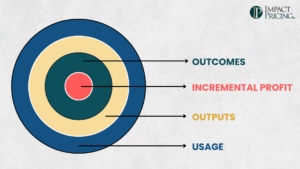You can listen to the full audio version of this blog we call — Blogcast.
Several recent posts mentioned Value Tables, and a couple of people asked about them. Value Tables are a systematic and powerful framework to estimate the value of a product or feature.
Let’s start with a feature. As an example, let’s use the value of integrating your CRM with your billing system. I “randomly” chose that feature because it’s seemingly inconsequential, but still important.
Before we go too far, think to yourself. What is the value of this feature to any specific customer?
Let’s answer that question using a Value Table. A Value Table has 4 columns: Solution, Problem, Result, and Value.
The Solution is your product or a marketable product feature. These are features your marketing and sales team talk about because they think buyers might care. The solution in our example is the integration of a CRM into the billing system for this example.
You built that feature because it solves a problem for your customers. What is that problem? This is the hardest column for most people to do well. You have the curse of knowledge, meaning you know so much about your product you don’t remember what it’s like to not know. Here are a few problems this integration could solve.
- We waste time by manually entering a customer’s data twice.
- Sometimes, we enter the wrong quoted price into the billing system. When we bill too much, our customers get angry. When we bill too little, they don’t say anything and we lose money.
- We don’t have accurate win/loss data, which means we aren’t tracking trends and can’t easily see the impacts of our latest sales initiatives.
We could list more, but three is enough for our example. You want to list as many as you can think of. Each problem is at least one new row in your value table.
The next column is Result. If a buyer with one of these problems buys and implements your solution, what is a quantitative result they could expect? Think of this column as “what customer KPIs will you impact?” Let’s go through the three problems listed above.
- We get about 50 orders from new customers each day. It takes about 5 minutes to carefully enter the new customer data, so we use 250 minutes a day entering data. Let’s call that 4 hours or ½ of a day. Integration would take that to zero.
- We make about one billing error per week. Half are in the customer’s favor. The average error is $100. Integration should cut those errors in half.
- By integrating our CRM and billing systems, we will be able to know which quotes from the CRM turned into orders. Hence we will get accurate win/loss data. By using win/loss to tweak our sales processes, we should be able to increase a salesperson’s effectiveness by at least 1%.
These results are simply your best guess. They don’t have to be perfect. You are not trying to prove your value with a Value Table. Instead, you are trying to figure out your true value to your customers. Your sales team should NOT present these numbers at facts. Instead, they should be asking the potential buyers about what results they hope or expect to get. The Value Tables show your salespeople where to look for the value, not what the value is.
The final column, Value, is incremental profit to your customer determined using business acumen. Let’s go through our three results.
- The fully burdened cost of a data entry person is $50,000. Half of that is $25,000.
- 26 data entry errors at $100 each is $2600. Stopping half of those saves us $1,300.
- If we could make each salesperson 1% more effective, that’s the same as increasing our overall revenue by 1%. Since we are a $20M company, that’s an additional $200,000 in revenue. At 60% gross margin, that’s $120,000 in incremental profit.
Again, please do not think your sales people are telling these numbers to your customers. Instead, they are walking them through the math while the buyers make up their own numbers and do their own calculations.
What’s interesting about these three examples is when I asked you in the beginning what the value is, you probably came up with the first one. After you read the three problems, you probably thought the second one was the most valuable. Now that you’ve seen this, and if you believe it, the last one may be the most valuable, by far. The value of solving different problems is often non-intuitive.
My recommendation is to list your marketable product features. For each one, list the problems it could solve. Then, for each problem, what results might your customer achieve? Finally, how do you calculate incremental profit derived from that result? It’s a lot of work, and it’s not easy, but after you do this you will have a far better understanding of what value means to your buyers.
Share your comments on the LinkedIn post.
If you want more information, read Chapter 4 of the book Selling Value. And if you want help, reach out to me at [email protected].
Now, go make an impact!
 Tags: selling value, selling value book, value, value table
Tags: selling value, selling value book, value, value table













